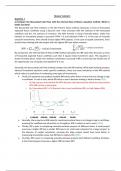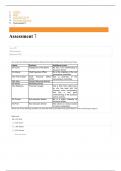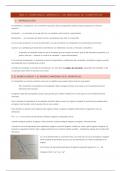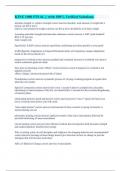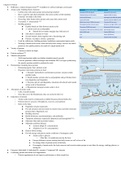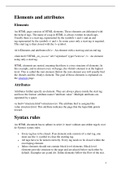Depression Part 2
1: Sad babies, toddlers and adolescents
Fergusson et al. (2002): Mental health, educational and social role outcomes
of adolescents with depression
Introduction
- Pathways that may explain linkages between early depression and later outcomes:
- There may be a direct effect of depression on later outcomes, therefore
depression may lead to impaired educational achievement.
- It is possible that the associations between early depression and later outcomes
are noncausal and reflect the presence of antecedent factors that are associated
with increased risk of depression.
- It is possible that the linkages between early depression and later outcomes are
mediated by the presence of comorbid disorders.
Subjects and methods
- Longitudinal study with 1265 children born in New Zealand, were studied at birth, 4
months, 1 year, annual intervals to age 16 years and again at ages 18 and 21.
- The aims of the study were to examine the continuities between adolescent depression
later outcomes and to explore the possible routes by which these continuities may arise.
Results
Relationships between adolescent depression and later outcomes
- Adolescents with depression were at increased risk of a range of subsequent outcomes
between ages 16 and 21, including: later depression, anxiety, nicotine dependence,
alcohol abuse or dependence, suicidal behavior, school failure & reduced likelihood of
entering a university or pursuing another form of tertiary education.
- At age 21, adolescents with depression were characterized by higher rates of recurrent
unemployment and early parenthood.
- Similar results for boys and girls.
Social, familial and individual factors associated with depression in early adolescence
- Adolescents with and without depression had similar socioeconomic backgrounds.
- Adolescents with depression were more likely to have been exposed to sexual abuse
and parental change during childhood. Tendency to have had lower IQ scores at age 9.
Tendencies to neuroticism, higher rates of deviant peer involvement in adolescence,
higher rates of comorbid anxiety disorders, conduct disorders and alcohol abuse + more
likely to smoke.
Relationship adolescence depression and later outcomes, adjusted for confounding factors
- The elevated rates of these outcomes among teenagers with depression reflected the
antecedent social background, familial and personal factors that were associated with
adolescent depression and increased risk of later adverse outcomes, rather than the
direct effects of depression on later adjustment and life experiences.
Limitations
- Specific group of children have been investigated.
- Assessment of depression during adolescence relied on young people’s retrospective
reporting of depressive symptoms. It is unclear how many depressions were clinical.
- Self-reported data.
,Zhou et al. (2020): Comparative efficacy and acceptability of
antidepressants, psychotherapies and their combination for acute treatment
of children and adolescents with depressive disorder
Introduction
- Aim of study: look at the efficacy of antidepressants, psychotherapies and their
combination for depression in children and adolescents.
- Meta-analysis/systematic review
Results
Efficacy
- Only fluoxetine (SSRI) plus CBT and fluoxetine were more effective than both pill
placebo and psychological controls.
- Fluoxetine plus CBT was more effective than CBT and psychodynamic therapy.
- Interpersonal psychotherapy was more effective than all psychological controls.
- Nortriptyline (TCA) and waiting list were worse than most active interventions.
- Studies with severly depressed people had larger treatment effects.
Acceptability
- Nefazodone (SARI) and fluoxetine were associated with fewer dropouts than sertraline
(SSRI), imipramine (TCA) and desipramine (TCA).
- Imipramine was associated with more dropout than pill placebo, desvenlafaxine (SNRI),
fluoxetine plus CBT and vilazodone (SSRI).
- Venlafaxine (SNRI) was associated with an increased risk of suicidal behavior or ideation
compared with pill placebo and other interventions.
Discussion
- Of all the included active interventions, only fluoxetine plus CBT and fluoxetine alone
were significantly better at treating depression than pill placebo in children and
adolescents with depressive disorders
- There was also a benefit of interpersonal therapy compared to psychological controls
- The effect sizes for these comparisons were in the medium to large range, though there
was relatively high variability (uncertainty) and the quality of evidence was considered
low.
Harmer (2020): Antidepressants and psychotherapy for adolescent
depression. Can they be compared?
Talks about study by Zhou ^
- The authors note that the benefit seen in these studies with children and adolescents
was less consistent across drug and psychological treatments than that typically seen in
studies in adults, where most of these treatments were effective compared to controls.
- This may be because of key developmental differences in biological, cognitive
and social development in adolescents which are likely to modify the impact of
treatment interventions.
- It is also possible that since there are far fewer treatment studies in adolescents,
with generally higher levels of placebo response, that there may be insufficient
statistical power to make meaningful comparisons between treatments.
- This meta-analysis also confirmed that treatments were largely acceptable in terms of
numbers of patients withdrawing from therapies, though imipramine fared less well in
this comparison, consistent with higher levels of side effects associated with TCA
treatment.
- In 2004, the FDA placed a black box warning on antidepressants for increased risk of
suicidal thoughts and behavior in children and adolescents. In this analysis, suicidality
data on psychological and combination interventions were systematically investigated
, using the same approach used for medication alone. This showed that the SNRI,
venlafaxine, which potentially increases levels of noradrenaline as well as serotonin in
the brain had a significantly increased risk for suicidality compared to other treatments.
However, suicidality was not increased with other antidepressants including the more
widely studied, fluoxetine, in comparison to psychological treatments, which is
reassuring given earlier concerns.
Strengths and limitations
- This kind of evidence synthesis can help inform choices between different treatment
options and their combination. However, this integration is both a strength and a
potential weakness in the meta-analysis and review since trials with varying
interventions have tended to be performed in quite different ways making statistical
comparison difficult. For example, there was a relative lack of blinding in psychological
treatment trials (so patients and clinicians knew which treatment had been received).
Indeed, the higher level of regulation for clinical trials involving drug treatments was
associated with a more detailed level of reporting. In contrast, there was some evidence
of reporting bias for psychological treatment research and information on suicidality
was often absent. However, it must also be acknowledged that antidepressant trials that
compare drugs with inert placebo may also be difficult to blind successfully.
- More primary research is needed to evaluate combination treatments and the best way
to join up these different treatment options.
- This meta-analysis focused on relatively short-term efficacy after a median of 8 weeks of
treatment. However, it is important to consider longer term treatment effects and data
on relapse of depression as well. Although psychological treatment action did not
emerge strongly in these comparisons, psychological interventions may well be more
effective when considering longer term effects and effect on relapse.
- We need more studies and more statistical power to address some of these key
questions. Standard clinical depressive rating scales (reported by most studies) capture
only a relatively narrow range of symptoms and a focus on other outcome measures of
relevance to patients is badly needed. Additionally, more head to head comparisons of
psychotherapies and antidepressant treatments are required and it will be very
important to identify treatment predictors to one modality or another.
Her own review
- SSRIs have therapeutic efficacy in depression and also anxiety in young people, though
they do not work for everyone and more treatment options are needed.
- There is limited systematic evidence for whom they work best; this is a really important
question to address because it could help target antidepressant treatment more
effectively.
- There was little work on mechanisms of antidepressant action in young people which is
critical to improve treatment development in this age group.
- There was emerging evidence that SSRIs may affect brain circuits important in emotional
response and regulation which over time leads to improved mood and alleviation of the
symptoms of depression.
- As in the Zhou et al.,(2020) review we did not find evidence for increased suicide during
SSRI treatment in young people. Typical side effects (as in adults) do occur but these
tend to lessen with time.
- However, the long-term effects of taking antidepressants during the teenage years are
not well understood.
- On one hand we know that untreated depression can have long-lasting
deleterious effects which extend into adulthood.
1: Sad babies, toddlers and adolescents
Fergusson et al. (2002): Mental health, educational and social role outcomes
of adolescents with depression
Introduction
- Pathways that may explain linkages between early depression and later outcomes:
- There may be a direct effect of depression on later outcomes, therefore
depression may lead to impaired educational achievement.
- It is possible that the associations between early depression and later outcomes
are noncausal and reflect the presence of antecedent factors that are associated
with increased risk of depression.
- It is possible that the linkages between early depression and later outcomes are
mediated by the presence of comorbid disorders.
Subjects and methods
- Longitudinal study with 1265 children born in New Zealand, were studied at birth, 4
months, 1 year, annual intervals to age 16 years and again at ages 18 and 21.
- The aims of the study were to examine the continuities between adolescent depression
later outcomes and to explore the possible routes by which these continuities may arise.
Results
Relationships between adolescent depression and later outcomes
- Adolescents with depression were at increased risk of a range of subsequent outcomes
between ages 16 and 21, including: later depression, anxiety, nicotine dependence,
alcohol abuse or dependence, suicidal behavior, school failure & reduced likelihood of
entering a university or pursuing another form of tertiary education.
- At age 21, adolescents with depression were characterized by higher rates of recurrent
unemployment and early parenthood.
- Similar results for boys and girls.
Social, familial and individual factors associated with depression in early adolescence
- Adolescents with and without depression had similar socioeconomic backgrounds.
- Adolescents with depression were more likely to have been exposed to sexual abuse
and parental change during childhood. Tendency to have had lower IQ scores at age 9.
Tendencies to neuroticism, higher rates of deviant peer involvement in adolescence,
higher rates of comorbid anxiety disorders, conduct disorders and alcohol abuse + more
likely to smoke.
Relationship adolescence depression and later outcomes, adjusted for confounding factors
- The elevated rates of these outcomes among teenagers with depression reflected the
antecedent social background, familial and personal factors that were associated with
adolescent depression and increased risk of later adverse outcomes, rather than the
direct effects of depression on later adjustment and life experiences.
Limitations
- Specific group of children have been investigated.
- Assessment of depression during adolescence relied on young people’s retrospective
reporting of depressive symptoms. It is unclear how many depressions were clinical.
- Self-reported data.
,Zhou et al. (2020): Comparative efficacy and acceptability of
antidepressants, psychotherapies and their combination for acute treatment
of children and adolescents with depressive disorder
Introduction
- Aim of study: look at the efficacy of antidepressants, psychotherapies and their
combination for depression in children and adolescents.
- Meta-analysis/systematic review
Results
Efficacy
- Only fluoxetine (SSRI) plus CBT and fluoxetine were more effective than both pill
placebo and psychological controls.
- Fluoxetine plus CBT was more effective than CBT and psychodynamic therapy.
- Interpersonal psychotherapy was more effective than all psychological controls.
- Nortriptyline (TCA) and waiting list were worse than most active interventions.
- Studies with severly depressed people had larger treatment effects.
Acceptability
- Nefazodone (SARI) and fluoxetine were associated with fewer dropouts than sertraline
(SSRI), imipramine (TCA) and desipramine (TCA).
- Imipramine was associated with more dropout than pill placebo, desvenlafaxine (SNRI),
fluoxetine plus CBT and vilazodone (SSRI).
- Venlafaxine (SNRI) was associated with an increased risk of suicidal behavior or ideation
compared with pill placebo and other interventions.
Discussion
- Of all the included active interventions, only fluoxetine plus CBT and fluoxetine alone
were significantly better at treating depression than pill placebo in children and
adolescents with depressive disorders
- There was also a benefit of interpersonal therapy compared to psychological controls
- The effect sizes for these comparisons were in the medium to large range, though there
was relatively high variability (uncertainty) and the quality of evidence was considered
low.
Harmer (2020): Antidepressants and psychotherapy for adolescent
depression. Can they be compared?
Talks about study by Zhou ^
- The authors note that the benefit seen in these studies with children and adolescents
was less consistent across drug and psychological treatments than that typically seen in
studies in adults, where most of these treatments were effective compared to controls.
- This may be because of key developmental differences in biological, cognitive
and social development in adolescents which are likely to modify the impact of
treatment interventions.
- It is also possible that since there are far fewer treatment studies in adolescents,
with generally higher levels of placebo response, that there may be insufficient
statistical power to make meaningful comparisons between treatments.
- This meta-analysis also confirmed that treatments were largely acceptable in terms of
numbers of patients withdrawing from therapies, though imipramine fared less well in
this comparison, consistent with higher levels of side effects associated with TCA
treatment.
- In 2004, the FDA placed a black box warning on antidepressants for increased risk of
suicidal thoughts and behavior in children and adolescents. In this analysis, suicidality
data on psychological and combination interventions were systematically investigated
, using the same approach used for medication alone. This showed that the SNRI,
venlafaxine, which potentially increases levels of noradrenaline as well as serotonin in
the brain had a significantly increased risk for suicidality compared to other treatments.
However, suicidality was not increased with other antidepressants including the more
widely studied, fluoxetine, in comparison to psychological treatments, which is
reassuring given earlier concerns.
Strengths and limitations
- This kind of evidence synthesis can help inform choices between different treatment
options and their combination. However, this integration is both a strength and a
potential weakness in the meta-analysis and review since trials with varying
interventions have tended to be performed in quite different ways making statistical
comparison difficult. For example, there was a relative lack of blinding in psychological
treatment trials (so patients and clinicians knew which treatment had been received).
Indeed, the higher level of regulation for clinical trials involving drug treatments was
associated with a more detailed level of reporting. In contrast, there was some evidence
of reporting bias for psychological treatment research and information on suicidality
was often absent. However, it must also be acknowledged that antidepressant trials that
compare drugs with inert placebo may also be difficult to blind successfully.
- More primary research is needed to evaluate combination treatments and the best way
to join up these different treatment options.
- This meta-analysis focused on relatively short-term efficacy after a median of 8 weeks of
treatment. However, it is important to consider longer term treatment effects and data
on relapse of depression as well. Although psychological treatment action did not
emerge strongly in these comparisons, psychological interventions may well be more
effective when considering longer term effects and effect on relapse.
- We need more studies and more statistical power to address some of these key
questions. Standard clinical depressive rating scales (reported by most studies) capture
only a relatively narrow range of symptoms and a focus on other outcome measures of
relevance to patients is badly needed. Additionally, more head to head comparisons of
psychotherapies and antidepressant treatments are required and it will be very
important to identify treatment predictors to one modality or another.
Her own review
- SSRIs have therapeutic efficacy in depression and also anxiety in young people, though
they do not work for everyone and more treatment options are needed.
- There is limited systematic evidence for whom they work best; this is a really important
question to address because it could help target antidepressant treatment more
effectively.
- There was little work on mechanisms of antidepressant action in young people which is
critical to improve treatment development in this age group.
- There was emerging evidence that SSRIs may affect brain circuits important in emotional
response and regulation which over time leads to improved mood and alleviation of the
symptoms of depression.
- As in the Zhou et al.,(2020) review we did not find evidence for increased suicide during
SSRI treatment in young people. Typical side effects (as in adults) do occur but these
tend to lessen with time.
- However, the long-term effects of taking antidepressants during the teenage years are
not well understood.
- On one hand we know that untreated depression can have long-lasting
deleterious effects which extend into adulthood.

